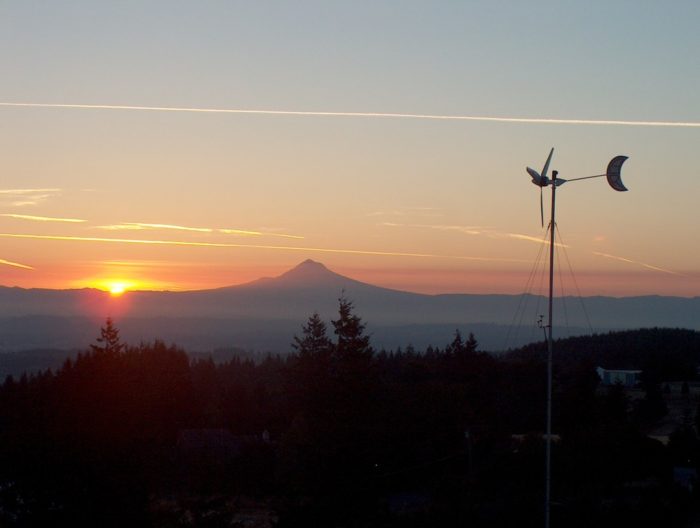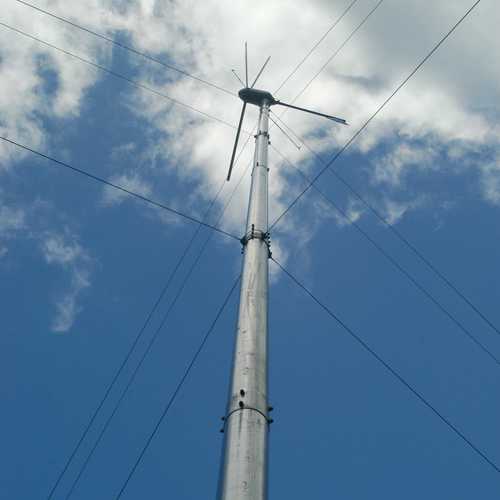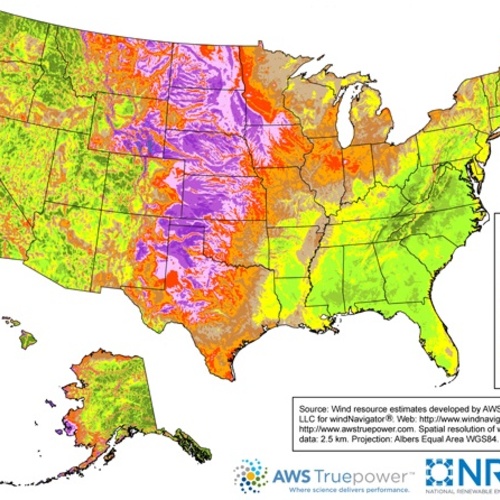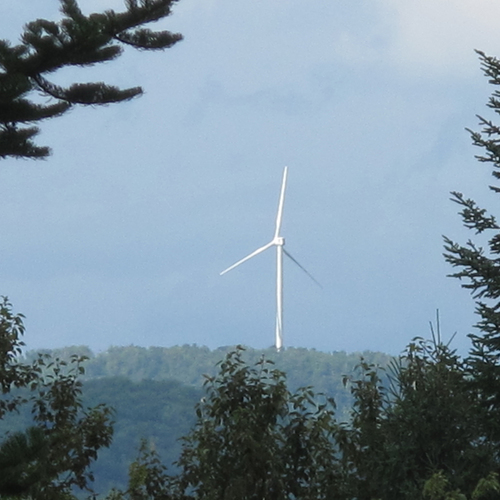
Image Credit: Abundant Renewable Energy
Wind turbines have a hypnotic allure. The Siren call of carbon-neutral electricity has led many environmentalists to dream of owning a backyard wind turbine.
Unfortunately, small wind turbines, unlike utility-scale wind turbines, are rarely cost-effective, even when installed at a good site. Installed at an average site, a wind turbine is little more than an expensive toy.
Most renewable energy consultants can share tales of small wind turbines that have disappointed their owners due to low energy production or frequent maintenance problems. That’s why it’s so important for wind-besotted greenies to do their homework before going turbine shopping.
Wind-generated electricity isn’t cheap
Even homeowners blessed with a fairly good wind site pay a steep price for wind-generated electricity.
One of only a handful of successful net-zero-energy homes in the U.S. is one owned by David Pill and Hillary Maharam of Charlotte, Vermont. Although most descriptions of their prize-winning house note that their 10-kW Bergey wind turbine generated more electricity during a 12-month period than the family used, few noted that their electricity is very expensive.
During its first year of operation, their wind turbine produced 6,286 kWh of electricity — worth about $627 at the current retail rate of $0.10 per kWh. That means that the $40,500 wind turbine will have a simple payback period of about 64 years. Unfortunately, the turbine is unlikely to last that long.
The same amount of electricity could have been generated by a 6-kW PV system, which the Pills could have installed for $30,000. Since their home was built, the price of PV has dropped; in 2013, a 6-kW system could be installed for $24,000 or less. (For a somewhat different payback analysis, see David Pill’s comment of 09/12/2011, posted in the comment section below this article.)
“In a good site, wind will be marginally cheaper than PV,” said…
Weekly Newsletter
Get building science and energy efficiency advice, plus special offers, in your inbox.

This article is only available to GBA Prime Members
Sign up for a free trial and get instant access to this article as well as GBA’s complete library of premium articles and construction details.
Start Free TrialAlready a member? Log in















10 Comments
Integration
Thanks for the focus of this post (interesting counterpoint to the "sustainable McMansion" piece by Richard Deffendorf). It goes hand and hand with a comment made in your EBN feature on solar by Steven Strong that, despite its unreasonable expense, architects (and their clients) love building integrated photovoltaics because you can see them (unlike a better envelope - note to self: work on artful expression of wall thickness).
It doesn't help that turbines are the most evocative icon of renewable energy - if there were as many operating (effectively) as there are on "green" web pages and featured in magazine articles and oil co. ads we'd be in good shape! People like shorthand and easy answers and wind turbines in backyards fit that bill. Let's hope your insight is observed and communicated. And where is the "eagle" of efficiency - we need an icon!
Tucked within your post is a really significant job description. Rob Meyers is the "energy efficiency and renewable energy integrator" at South Mountain Company. Now we're talking! Until we move beyond the fractured single line disciplines of roofing, siding, windows, insulation, HVAC, solar, wind, ground source, on demand DHW, and the third party auditor with no direct role in integrating all of the above (with hands tied by stimulus programs), we're going to have a hard time getting this to work (as in work together as a system, which is the point). Someone needs to play that role and be accountable to a client in assuring performance, while providing the kind of guidance that Rob offers and you are encouraging here. We need "integrators".
Wind Turbines as green dogma
Hi Martin,
I was recently thinking about the issues you bring up in this post with respect to one homeowner in my area who dogmatically pursued approval for a wind turbine installation in his backyard. Unsurprisingly, his pursuit of approval against the wishes of his neighbours has probably created a great deal of resentment.
The sad thing, for anyone who knows where the 'low hanging' green fruit lies, is that his home was a typical suburban home, built to the minimum standard (the code). The money he would have put into the turbine could have been put into improving the energy efficiency of his home, and would have had a much better (profoundly) cost/benefit ratio than the turbine. And he wouldn't have pissed off his neighbours!
The various levels of government, business and the consumer who want to be green seem to spend far too much time advocating/demanding for glamorous renewable energy and very little time cheer-leading the much more cost-effective load reduction and end-use energy efficiency approaches. It's understandable, load reduction and end-use energy efficiency is pretty homely looking compared with glamourous renewable energy. Anyone know how to make load reduction and end-use energy efficiency 'hot'?
Cheers,
Andrew
Nothing new here
Being one of the largest manufacturers of small-wind systems, the UK has conducted many studies on the performance of small-wind in residential application (see Warwick Wind Trials for example). Unfortunately, it's true; even with vast "wind resources" these reports note significantly lower performance than what wind energy yield tools predict. The problem is that wind is just inherently hard to predict or model - microclimate wind conditions (ie. affects of trees, buildings) can be completely different in two close locations, although they would share the same average wind speed which is used in predictions.
Having said that, all renewable energy products take time to reach economies of scale, learning curve improvements, so who knows where the industry could be in 10 or more years...
Integrators , Great concept that is sorely needed!
Great point from Jamie. More businesses whether they be small or large should incorporate design and building professionals as "energy efficiency and renewable technology integrators" into there staff. This is especially true for businesses that deal with residential clients. The green building movement is attracting many consumers who are not well educated on energy efficiency, energy load reduction, and the principles that can green an existing home prior to spending vast amounts of money on glitzy energy systems. Their decision to promote a green living environment for themselves, leaves much opportunity for an experienced professional to educate them on how to integrate different aspects of sustainable life and renewable energy systems into their homes. With the vast number of existing houses that need to be upgraded, and the economy forcing people to stay and renovate their homes "integrators" become sustainable living and green building "counselors". People need someone to essentially hold their hands and walk them through the design and construction process of upgrading their homes and lives. Educating the people spreads to others, and each client provides the professional with a personal experience that can be related to their next client. It is a symbiotic relationship that benefits everyone. Bravo to South Mountain Company for this innovative concept! E. J. Palma , Branford, Connecticut
turbines
if you feel that way why not check out a reputable dealer. The wind generators wind turbines at hurricane have done a great job for me actually lowering my power bill by half
Reputable dealers
Tom,
I have already checked out reputable dealers of wind turbines; however, checking out reputable dealers has not altered my conclusions.
I respect these reputable dealers, by the way, since wind turbines are useful equipment for off-grid homeowners. Many wind-turbine dealers do a great job serving the off-grid market.
wind
Sounds like Martin's working for the PV cell companies.
What causes such cynicism?
Anonymous,
It sounds as if the only possible explanation that someone might have a different perception than you do is that the opinion is being expressed by someone on the payroll of a corporation.
I think your level of cynicism is unnecessarily high. I can assure you that I have no relationship with any PV companies, and have often written blogs advising against investments in PV.
Clarification
Hi Martin-
Just happened to come across this article. I would have commented sooner. I would like to make some clarifications. Not that it matters to your point but our electricity costs $0 .14/kWh.
At the time PV was about 8 - 10 per watt. Our modeling showed that we would use approximately 8000 to 9000 kWh per yr so we would need around an 8kW to 9kW system. Using $8 per watt, the cost would have been between 64K and 72K. From wind maps it appeared that we would produce around 8000 kWh with the turbine at a cost of $40,500 so it made sense at the time. Also, you probably left out the rebates for a reason but the final cost was 28K, and with today's 30% tax credit (not available at the time) the final cost would be 16K. Now in 2011 with PV costing in the sub $5 per watt range, it would have been an obvious choice. While we definitely overpaid for our electricity in 2007 dollars by purchasing the wind turbine, by doing that we were able to pre pay all of our energy costs, including heat and HW, by wrapping that cost into our mortgage to be completely independent of any electricity or fuel price increases for at least the next 20 years.
Response to David Pill
David,
Thanks for the clarifications. They are much appreciated.
I have edited the blog to include a reference to your comment.
Log in or become a member to post a comment.
Sign up Log in